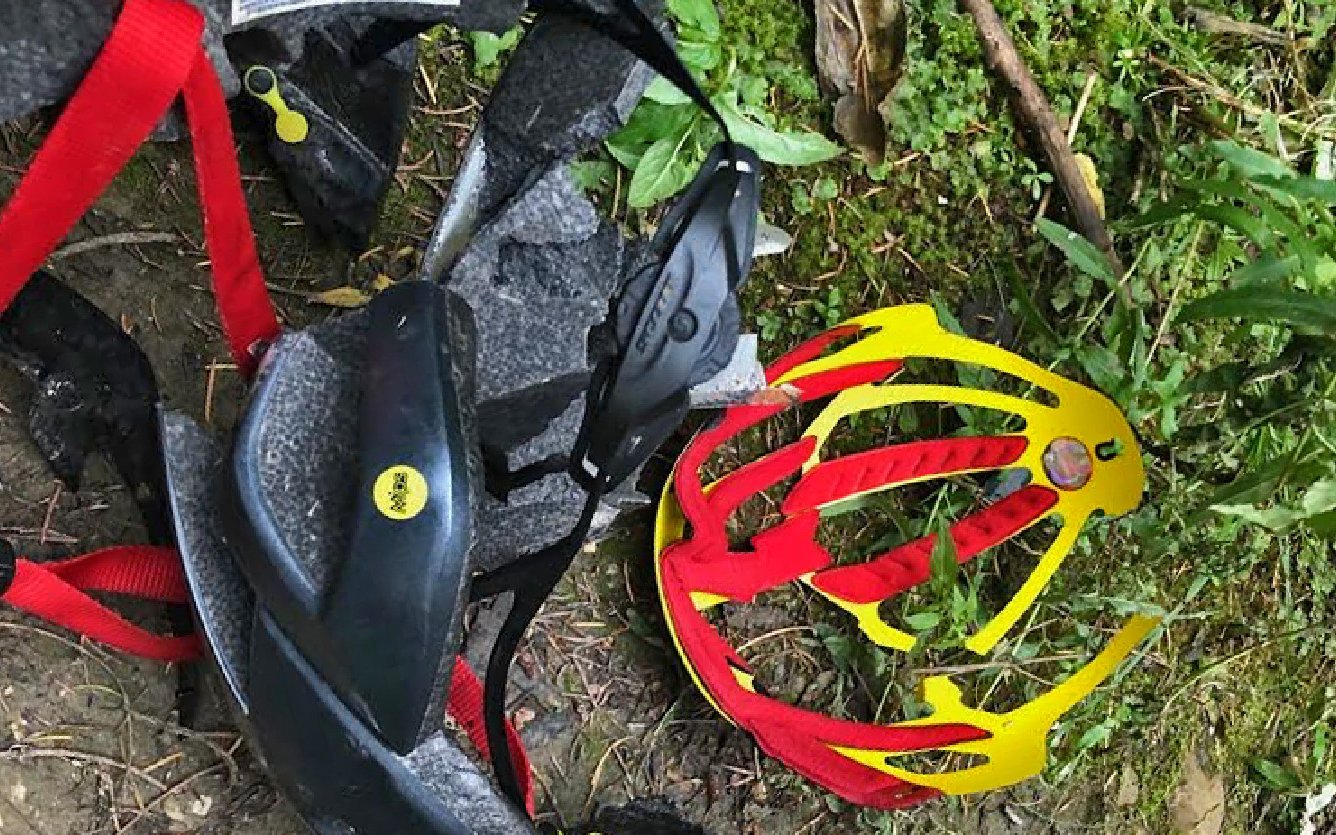
An ER Doctor's Bro Goes Down Hard
A Crash Story (with a Happy Ending)
We are aware that for many of you, dosing mountain bike media helps escape the headaches and pitfalls modern life can generate. And maybe even the pitfalls and headaches mountain biking can create. Flat tires are one thing but who doesn't cringe when a rider mentions an acquaintance who was recently placed on injured reserve because of some mishap, big or small. Of course we all wish they wouldn't happen, but they do and they will and pretending will not keep us out of harm's way.
Moritz submitted this article some time ago, and while there were communication challenges that affected the timing, I was also a little hesitant to hit the publish button. As I thought about it more, I realized that I felt compelled to share this educated wake up call, for myself and others, about the dangers of our sport. Every ER physician I've ever talked to has said that most serious mountain bike injuries, like the one outlined below, are sustained on higher-speed trails, and usually flow trails with berms and jumps. For those of us in the northern hemisphere, here's an early season reminder to play it safe and take some simple precautions to keep us all rolling on two wheels this summer. - Cam McRae
I’ve been riding mountain bikes for a long time. Long enough to remember when riding up Moose mountain access road in Bragg Creek, Alberta to bomb back down was considered fun. The memory of not being able to see from being rattled around so hard on my fully rigid aluminum Cannondale with its super stiff Pepperoni front fork is one that sticks with me vividly. These early bikes had a speed limit built in, so to speak. Above that speed, they just weren’t all that fun to ride. Obviously technology has come a long way since the early 90’s, and so has the level and speed of the riding. Nowadays it's much easier for even riders of meager skills, like myself, to reach speeds once reserved for the John Tomacs of the world.
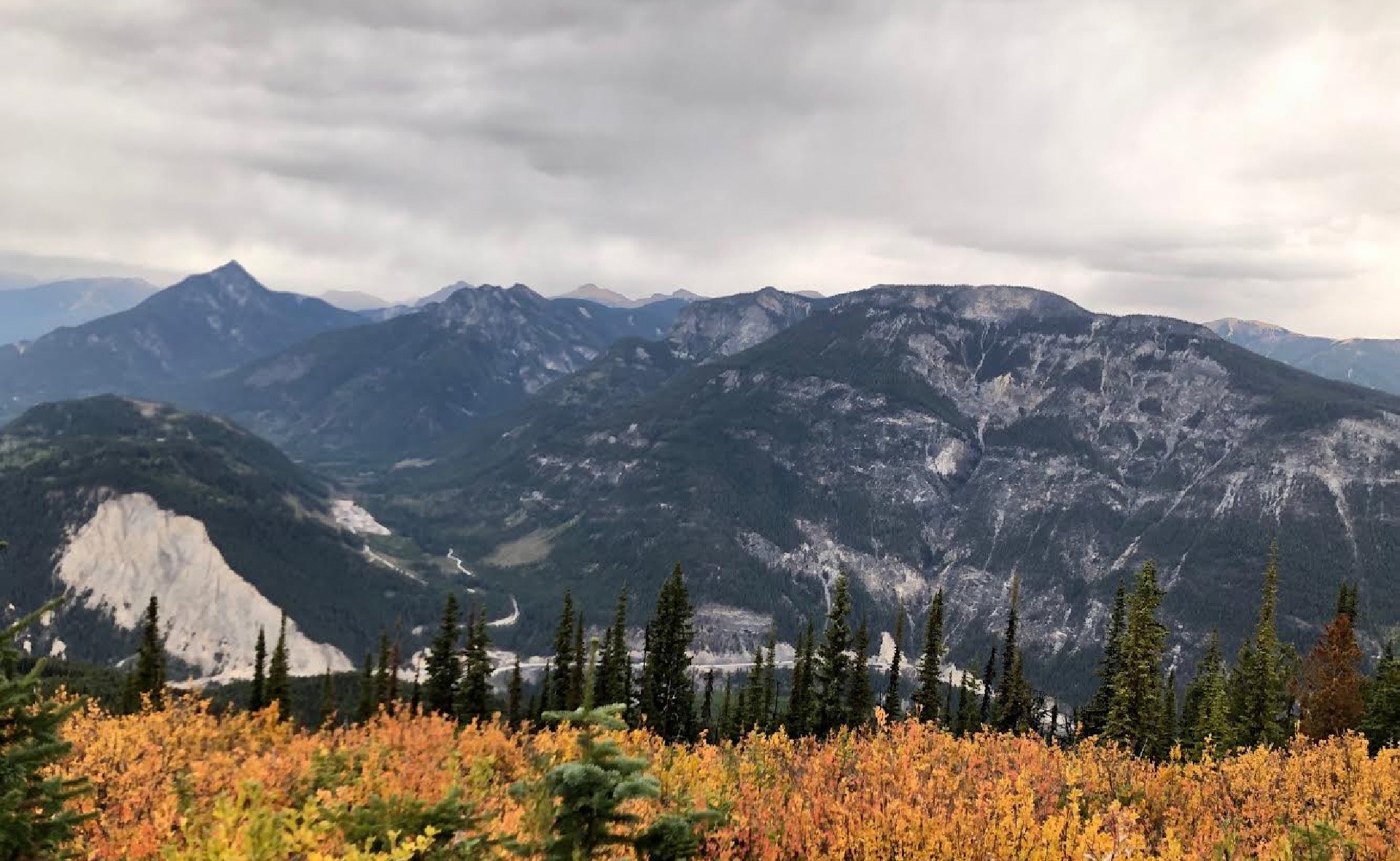
The events described herein took place on Mount 7 in Golden B.C.
The worst thing I ever did for my riding was to become an Emergency Physician. It’s nearly impossible to remain unaffected after seeing people paralyzed from cervical spine injuries, or in a vegetative state from devastating brain injuries. I’d find myself subconsciously just scrubbing that little bit of speed on sketchy corners, or giving that drop a pass more than most. On visits to BC I’d find myself marvelling at the scale of the technical trail features, and the skill and cajones it would take to ride those. I couldn’t help but feel a bit inadequate in my riding when I just wouldn’t even consider trying most of these.
Big air and big drops were the obvious things to avoid, but riding fast was becoming easier than ever. Long and slack bikes, and effective suspension with XC bikes sporting more travel than the DH bikes of yesteryear have significantly raised descending speeds. Strava segments also tend to push you that little bit extra. Keeping your wheels on the ground (mostly) just automatically feels safe. Yet that speed comes at a price, and that price is a significant increased risk of serious injury. Recently I had an experience that really drove this point home. One that is bound to affect my riding further.
We were on a bike trip in Golden B.C. My younger brother, my best friend, and myself. Really doesn’t get much better than this. We had finished a very long climb to the top and were reaping the reward on the descent down. Beautiful buff single track with endless berms and turns. A blue trail on Mount 7 called Schacher. I had a new bike, and was eager to really see what it could do. We were pushing the pace for sure. My brother was a few seconds ahead of me so I did not see the crash. I found him wedged between two large trees. The trail there had taken a little jog left, and there was a patch of wet dirt right before. His helmet was smashed into 4 pieces hanging off his head. Luckily he was conscious. Feeling like a mechanic without his toolbox, I quickly assessed him. He did not complain of neck pain, and was not tender. He also exhibited almost no signs of concussion which I found impossible to comprehend given the state of his helmet. He did complain of pain in his left arm and numbness in his left fingers though there was nothing to find on exam. He figured he’d hit the tree with his hand.
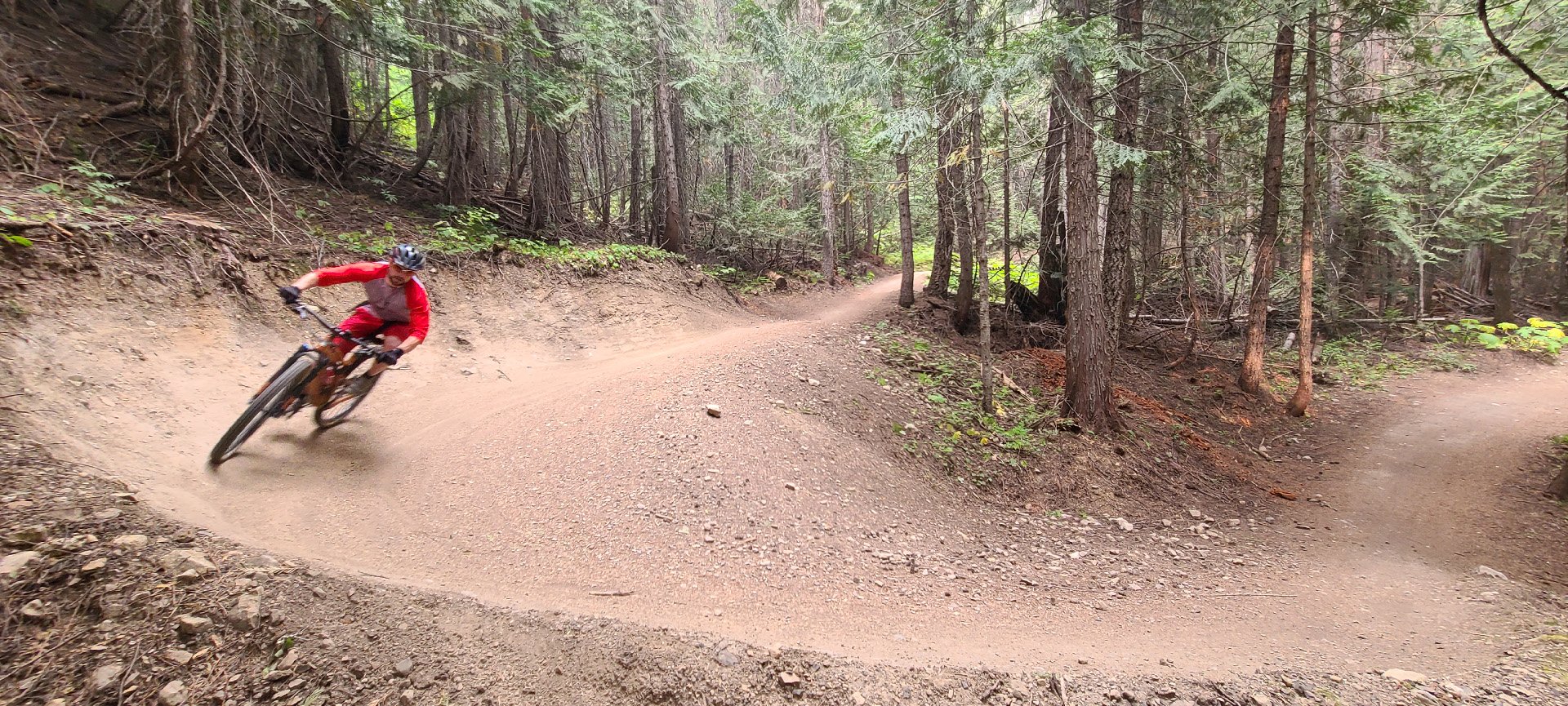
Moritz' brother riding on a happier day.
I rode down to get the car while my brother and my friend walked down the trail until they hit the road. We then took him to the local Emergency Department. He still had no neck pain, but he was holding himself funny, and complained of tightness across his shoulders. An x-ray of his neck revealed that he had broken it. Badly. In medicine we describe the spine as consisting of 3 columns. Like a 3 legged stool, the chances of your spine standing up by itself diminish the more legs you break. He had broken 2 of his 3 columns, making this an unstable fracture. Theoretically, this could allow the bones to move and damage the spinal cord. It takes very little energy to damage the spinal cord itself, and that kind of damage is irreversible. He underwent surgery to stabilize things and then faced a 3 month recovery in a hard collar.
There is no doubt in my mind that we got very lucky with this outcome. No paralysis, no significant head injury. I am sure the helmet saved his life. Likewise there is no doubt in my mind that the speed at which we were going lead to this accident. There are studies that show that decreasing the speed a car is travelling by only 10 km/h significantly improves the chances of survival of a pedestrian being struck by said car. Hence the recent move towards 40 Km/h speed limits in my neck of the woods. Smooth blue flow trails are so much fun to rip down at speed, but that speed carries a significant cost, and one that is all too easy to forget. I got back on my bike 3 days after the accident. I was anxious. I decided to just slow down, just a tad. Not tentative, but just to focus on being smooth. The good news is I still had fun, I did not feel lame. It was just me and my bike, rolling through the forest, thankful for being able to do what I love, and accepting of my own limitations, both those inherent to my skill level, and those newly self-imposed.
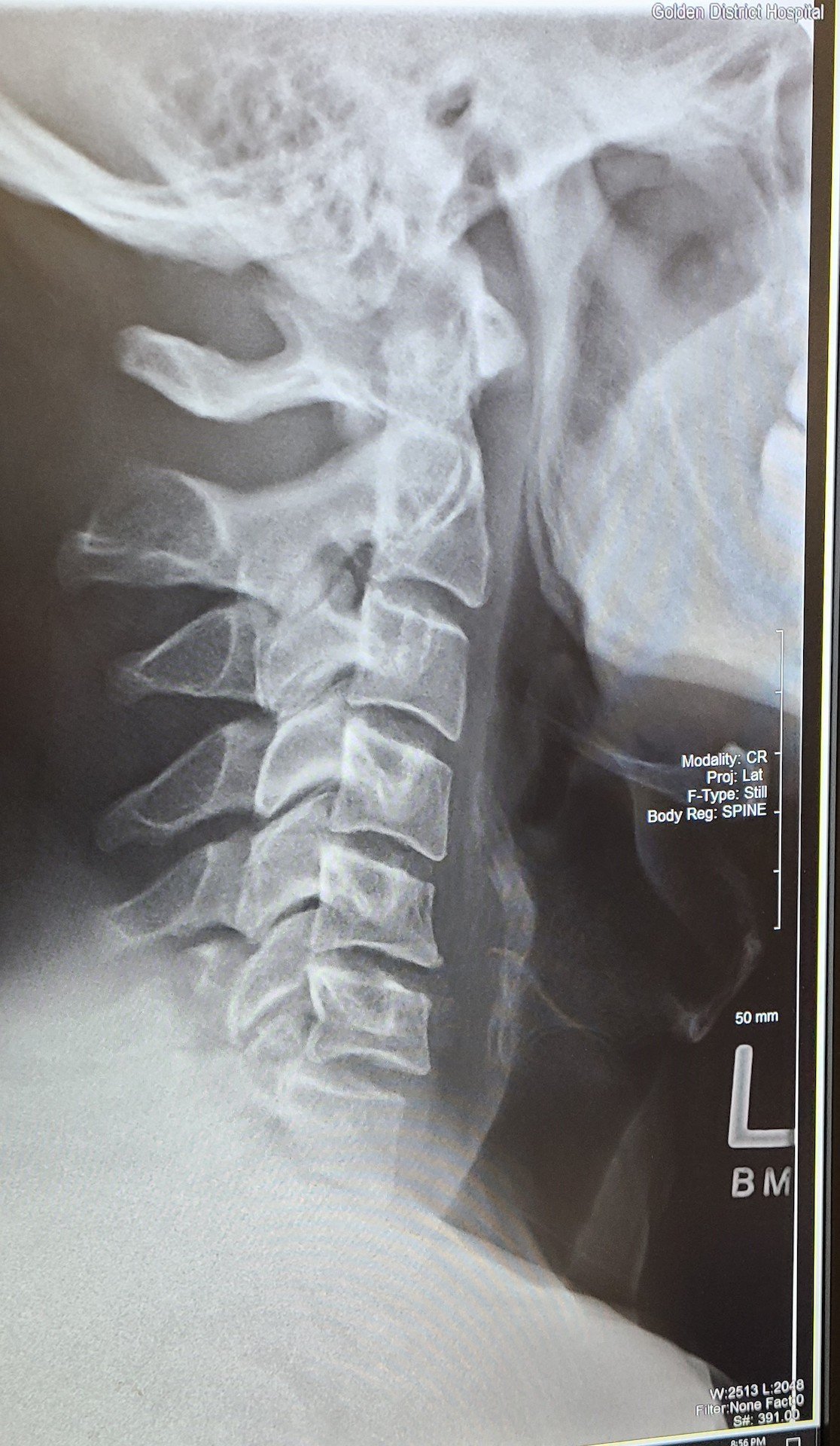
The offending vertabrae...
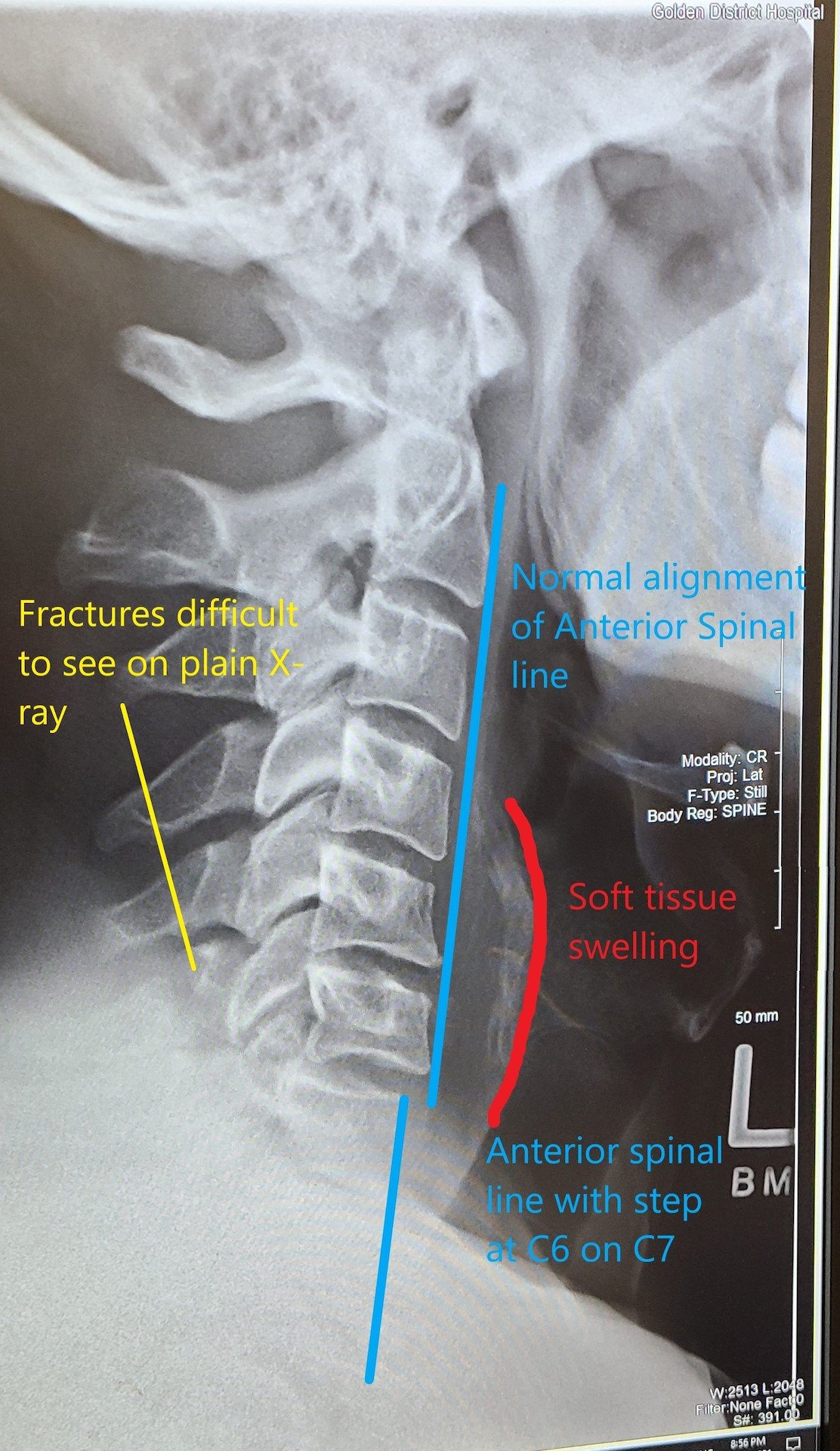
Some notes from Moritz on the injury.
I wanted to know more about this situation with the perspective of Moritz experience as an ER Physician. Here's our exchange.
Cam McRae Can you tell me a little more about your brother?
Moritz - He’s 41, 7 years younger than me. He’s a phenomenal athlete. He won Junior nationals at 17 yo in XC skiing, and ran something like a 2:44 in the Boston Marathon. He’s got 3 kids aged 4 to 10. He’s got good technical riding skills and has been hitting the bike park with his 10 year old in Calgary this year. He always pushes himself, and by extension me, and does not sit still very well. I think being inactive for this long might kill him. (thankfully it did not! -Ed.)
What sort of mechanism of injury would you expect to have resulted in the damage to your brother's spine?
This was a rotational injury -- his head hit the tree on the left side and caused his head to rotate forecefully to the left beyond the natural range of motion. This resulted in tearing of some ligaments that hold the bones toghether, damage to the disc between the C6 and C7 vertebrae, as well as fractures to the bone itself, specifically part of the bony ring that surrounds the spinal cord.
Aside from not crashing(!) is there anything that could have prevented this injury in terms of protective gear or anything else?
Helmets appear to provide some benefit in preventing neck injury as well as brain injury. One could postulate that the MIPS system which he had may have helped as its designed to decrease these type of rotational forces but that is purely speculative. Protecting the cervical spine specifically focuses on limiting the range of motion that it can be moved through. What makes the C-spine unique compared to the thoracic and lumbar spine is that its by far the most mobile. This has obvious benefits allowing us to look around, but it also means we have this giant weight (our head) on this relatively spindly and mobile column able to rotate sideways and up and down. The only successful devices so far are those that prevent primarily hyperextension i.e. limit the range of motion in looking up. The HANS device in F1 is said to protect against rotational injury as well, and looking at it I can sort of see how it might do that, but you have to keep in mind that F1 drivers don't turn their heads a lot, and I think using it on a bike would be pretty much impossible. There are other proposed devices being studied but nothing on the immediate horizon, The one thing that would help, and is something I'm planning on doing more, is specifically strengthening neck muscles.
What do you think his prognosis is after his three months in the collar both in terms of day to day living?
Currently he can't do much. He needs to wear the collar, and can't excercise or lift anything at this time. He tells me sleeping is very uncomfortable. Long term he is very lucky. He should be back to basically normal once everything has healed in about 8 weeks or so. He will lose some flexibility in his neck as his C6 and C7 vertebrae have been fused basically becoming one very large vertebrae and it remains to be seen how much that will affect him. I think MTB riding with its upright position should be fine, but if he was still doing Triathalons the aero bar position might be challenging. He is at increased risk of arthritis higher up in his neck as the remaining vertebrae have to compensate for the loss of flexibility in the lower neck.*
*Moritz brother is doing great now and his collar is long gone. He has been running and road riding for some time and he's just started riding on trails again.
Will he be any more susceptible to a spinal injury in the future as a result of this injury?
The answer here is a wishy washy maybe. The C6 and C7 should area itself should be stronger than before given its also reinforced by a titanium plate. The question are 1. how well the ligaments will heal as ligaments can heal poorly due to having a poor blood supply, and 2. will the increased rigidity in the lower neck increase chance of injury at a higher level by being more of a rigid fulcrum. This is mostly theoretical. The neurosurgeon who did his surgery certainly expects him to get back to biking.
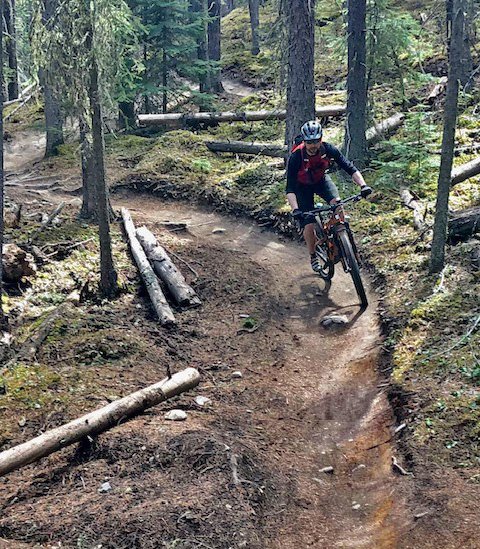
All healed up (or mostly) and riding Odyssey at Canmore Nordic Centre. Our injured warrior has made a full recovery and has just recently started riding mountain bikes again.
Have you noticed any patterns among riders who sustain these sorts of injury in the course of your work?
Interestingly I have not seen a ton of spine injuries from biking specifically. I think that that is related to where I live not being a huge biking epicenter, as well as the hospital where I work being more inner city, and the more afluent cyclists are likely to be seen elsewhere. That being said cycling injuries are common enough that a cycling injury is defined as a high risk mechanism in a widely used clinical decision rule that helps us decide when a patient requires X rays or not. Most of the spine injuries I have seen are from motor vehicle accidents and falls. Moto cross crashes and ATV accidents are common mechanisms and 2 risk factors that really stand out are intoxication (alcohol or drugs including marijuanna) and older age.
A year later and Moritz' brother is doing great. He's back running and road cycling, and he's recently started reintegrating mountain biking to his life. But, as Moritz laid out clearly, he was very lucky.
Let's be careful out there shall we?
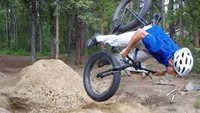
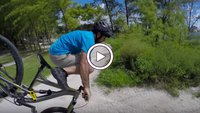
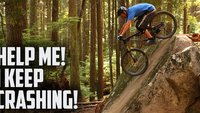
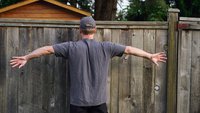







Comments
Cr4w
1 year, 10 months ago
Wow that's a hell of a story with a very fortunate outcome. Could you share your neck strengthening regimen? I've spent the last few years working on spinal mobility and flexibility (mostly through pilates) and functional strength (power lifting and kettlebells) and I'm 100% sure this has improved my crash survivability a great deal. I also shifted my riding focus to riding well rather than fast. Obviously I still ride fast but I try to aim for perfection: hit my lines, smooth arcs and transitions, no dabbing, nailing my shifting and gearing choices, etc. I let speed emerge from that precision otherwise I just cruise.
What exercises and movements have you added to your rehab/prehab training? Do you have a facility/coach you like specifically for this?
Reply
Moritz Haager
1 year, 10 months ago
Wow! I didn't realize this article was coming out today. Cam did a great job of editing it. I really love how it reads. Only correction is that the last picture of my brother riding is on Odyssey at Canmore Nordic Centre, not Fernie, just for accuracies sake. One of the things I love most about NSMB is that the comment section discussion is so often really good with thoughtful, mature, and meaningful input. I really appreciate the positive responses and well wishes. Thank you everyone.
Regarding the neck strengthening regimen, I'm embarrassed to admit I haven't gotten there yet. Life has sort of done what it does and I just hadn't followed though, but now in my red faced state I am recommiting to this plan.
The whole head and neck injury prevention science in MTB is really not great in my opinion. I am certainly not an expert in this area (as an emerg doc we are jacks of all trades and masters of none, and keeping up with all the latest and greatest studies in all areas is pretty much impossible) but when I have searched for medical studies it's been really hard to find studies specifically on mountain biking. It's also hard to design studies that really prove that certain devices really do what they claim to do, and while you often find a lot of studies, once you really go through them you start to identify all sorts of problems with their design that really throws a lot of doubt on their findings
If there is interest, I am certainly open to working with Cam and taking the time to really comb through the literature and come back with a follow-up article to specifically come up with the best recommendations for preventing neck injury including a MTB specific neck strength regimen. Unfortunately my expectation is that I will not find great science that is going to give us a really definitive answer.
Until then be safe, ride within yourselves, and enjoy doing the activity we all love.
Reply
olaa
1 year, 10 months ago
Would love to get some input on strength training for injury prevention! I have looked for various exercises (for instance from F1 and MotoGP) but haven't found all that much that i use. Between skiing season and biking season, the neck takes a fair bit of punishment, so anything that helps would be great.
Reply
Cr4w
1 year, 10 months ago
I wonder if it's not so much a case of neck-specific exercises as general fitness. i.e. good flexibility, good muscular range, ability to stay braced and supported under load and duress, good breathing patterns, and a balanced diet of movement patterns (not just riding bikes). Plus good hip function which informs the lower back which informs the upper back/shoulders which have a huge effect on the neck. If all those relationships are working correctly you're in a good place safety-wise compared to someone with limited flexibility, poor core strength, bad posture from sitting/phone use and who rides in a state of non-breathing panic.
Reply
duplex
1 year, 10 months ago
Ortho doc here with particular interest in protective devices, especially since I also do a lot of downhill. This article came at an opportune time as I've been lately considering reaching out to a local biomechanics expert who's well published in orthopaedics and affiliated with my university. Hoping to really gather some more robust data regarding the efficacy of these devices outside of the industry sponsored work. Personally, when I do ride the big bike, I do wear a full-face with MIPS and a neck brace. Mechanistically and my understanding of the anatomy, it makes sense to me, but until it's supported with sound science, it is as you've said speculative. Your last comment, though, is what I harp upon the most when asked by fellow rides. Prevention of these injuries begins with the rider. Riding safely with sound equipment and within your skill is ultimately the best way to enjoy years of this awesome sport. Thank you for sharing your story.
Reply
BlazersDad89
1 year, 10 months ago
Mortiz, if your brother ever wants to chat, have him PM me. I'm 11 years into a spinal fusion after having my T1 replaced(not from a bike accident). C6 and C7 got fused together in the process(6 vertebae fused in total).
The good news is, doctors these days are pretty darn good and I'd definitely say that I bounced back to 99%. Hopefully it looks like your brother is doing the same. The bad news is that, while not as bad as a lower spinal fusion which has to handle more load from your body weight, he lost one of his shock absorbers for his spine and compressing forces tend feel localized in that area. Would not be surprised if things like jogging and other activities that involve repeated compressions eventually become tougher/painful.
Best of luck to your brother in his recovery.
Reply
fartymarty
1 year, 10 months ago
Cam - Thanks for posting this great story.
I recently resurrected my rigid Krampus and it has been a ton of fun. Speeds are a slower than my 140/140 Murmur but the grins are just as big, if not bigger. I can pretty much ride the same trails just with less risk as your body can only take so much.
I can see myself riding rigid more as it is fun connecting with the trail rather than trying to PR every trail you ride.
Reply
Andy Eunson
1 year, 10 months ago
I think many of us know this intuitively that the more skilled speed sport athletes crash less but when they do, the consequences may be worse. My only bike injury last season was on a fun blue trail with lots of wee jumps. I didn’t even crash but came off line and pulled hard to get back in control. Ten minutes later my neck was hurting. Causes me to be more careful. Sometimes one can be too careful and that leads to crashes.
Articles like this one are important as they make us aware of the risks. Too many times it’s all hero videos which don’t reference the risks. Not always though. The video where Wade Simmons broke his femur was an exception.
There are always going to be athletes that thrive on the risk taking. They can suppress the fear which is a skill I don’t have. I can get a rush cleaning a tough technical climb similar to riding a technical drop. Something that’s just a fear inducing low skill drop though and I’m probably walking. Things that take more guts than skill.
Reply
Vik Banerjee
1 year, 10 months ago
Having recently moved to an area with trails that are faster than my previous home trails [about twice the avg speed on most rides] I am 100% aware that these "easier" trails are more dangerous due to the higher speeds. Riding a hardtail. Working on being as smooth as possible not as fast as possible. Not virtual phone racing other chubby middle aged EWS wannabes. These are all part of my plan to survive the next decade of my MTBing career.
My two notable injury accidents so far in the new location were both speed related. I wasn't going exceptionally fast, but as soon as you go off the trail all the energy in your speed gets converted to impacts with hard objects like trees, rocks, etc...
My gut feeling is that slowing down 10% from my max doubles my safety margin. Given I am not a pro racer or even a great virtual phone racer that doesn't really change anything for me on the enjoyment front and pushing myself to ride well technically/smooth provides a lot of satisfaction.
Great article. We could use more discussion about important topics like this. I'm glad Moritz' brother is healing up well.
Reply
otagoboy
1 year, 10 months ago
I am also a mountain biking physician who has seen lots of trauma. Whenever I’m doing anything more than a lazy cruise on the green trails I have my full face and Leatt neck brace on. I know they aren’t perfect protection by a long shot, but they do improve the odds against cervical spine injuries. Amazes me so few EWS and World Cup DH wear the braces. They have no downside unless you are bothered by looks from other riders
Reply
silverbansheebike
1 year, 10 months ago
+1!!! Surprises me more riders everywhere dont wear them. I hope with the ressurection of the full face helmet, we might see some more.
Reply
AverageAdventurer
1 year, 10 months ago
The pinkbike whistler opening day poll had neck braces way down. I still religiously wear mine whenever I'm riding park or shuttling. The convertible full face (and lightweight breathable ones) and gnarlier pedal trails are really starting to throw a wrench in things. It blurs that line where I'm riding 90% as fast with half the protection. I don't know what solution there is out there but I know it's a problem.
Reply
Karin Grubb
1 year, 10 months ago
Oy, this one gives me a bit of PTSD, but I totally agree these discussions are so important!
As someone who has been through a major injury and sustained significant head and neck injuries, I can add my 2 cents to the neck strengthening topic! I was also very active in lifting beforehand and heard more than once that strength was the reason I survived my crash and am riding and walking today - so strength training is SO important for all riders! For already active folks, exercises I found very effective are:
- farmers carrys with shrugs,
- turkish get-ups (with heavy weight once your form is good),
- high rep shoulder work including shrugs and presses; and
- bent over exercises (like rows) that force neck extension and stability while other muscles are under working hard.
Chin-tuck and chin-tucked rotation exercises on all 4's (i.e. hands and knees) are great, especially when recovering from a neck strain - you could add a light resistance band around the back of the head once the normal chin-tucks on hands and knees feels easy.
Also lying on your back simply lifting your head up (but keeping it parallel to the floor) while applying using light pressure from your hand on the forehead helps engage the back of the neck.
Form and posture are always key, especially with the neck. Those, along with pilates, were pretty key to getting my neck back up and running again and also helped build the muscle that protected me in the first place!
Reply
hambobet
1 year, 10 months ago
Couldn't agree more re the speed issue on seemingly 'beginner' trails. The nearest example to me is Forest of Dean in the uk. Most of the trail centre features rough, rooty, tecchy fun, which you can't really go too fast on. However, they've fairly recently built a hard pack blue trail, which genuinely scares me 10 x more than any of the other trails on site...purely from the speeds you hit. The corners can be a bit loose, and there are unpadded trees at very conspicuous points that could do some serious damage. Funny how this trail is marketed to less-advanced riders, yet the consequences of a mishap here would be a thousand times worse in my opinion - more likely too due to the demographic riding it.
Reply
fartymarty
1 year, 10 months ago
The blue flow trails* at Bike Park Wales scare me more than red / black tech trails. They are well built but the speed you can hit are crazy fast.
* I tried some red flow trails and definitely don't have the skills or nads for black flows.
Reply
Doug Shannon
1 year, 10 months ago
Both Launchpad and the back end of Verderers have that new hard pack surface with loose, gravelly corners and they scare the crap out of me when riding with the kids. I get the mental split where I want the boys to go fast and be fearless, but at the same time I see all the broken collarbones and near-misses I've had when I look at the unpadded trees...
Reply
Niels van Kampenhout
1 year, 10 months ago
Good article and a good reminder that we are not invincible even though sometimes it feels like that on a good ride.
I was never a super fast rider but a few years ago I found my speed kept going up with bikes getting longer and slacker. Following a few high speed crashes that could have been bad I consciously slowed down my riding and (like other commenters) started focusing more on being smooth, being more in tune with the bike and the trail, finding flow instead of raw speed. Turns out I enjoy it more as well so it's a win-win.
Also (again like some other commenters) improving my strength and flexibility is hopefully helping to prevent injuries when I do crash.
Reply
otagoboy
1 year, 10 months ago
Just an article with statistics suggesting neck braces are genuinely useful
https://www.cyclenews.com/2018/12/article/neck-brace-effectiveness-study/
And in case you were wondering about how much faster motocross riders are than MTB, this quick test with LAPD radar and top pro riders shows their speeds are in the 30-40mph range (50-70kmh), so not radically different to bike park/DH/Enduro MTB riders.
https://www.dirtrider.com/speed-supercross/
Reply
shenzhe
1 year, 10 months ago
Thanks for linking to that article. A comment about it though, they don't mention how many people typically wear neck braces for the activities in their region. I don't know enough about MX, but it wouldn't surprise me to find out more people don't wear a brace than do. As such there's a chance the ratio of 239:26 is just because about 1/10 of people actually wear a neck brace.
I think the chart in section 5 is pretty supportive of the idea that neck braces help make the crashes less severe, along with the chart in section 6 that shows 3.5% of accidents were critical with a neck brace compared with 20% without. Additionally, given the total number of accidents being within shouting distance of each other, it further suggests that the neck brace is solidly a good idea to keep your neck safe (barring some weird: people with neck braces crash more often thing).
I'm not trying to throw shade on the Great Lakes EMS study or the article you linked, nor am I trying to pooh pooh the idea that neck braces are good/helpful (I think they are), I just wanted to make sure it was known that the study wasn't a complete slam dunk for braces. Having said that, it's possible that in MX neck brace usage is the opposite of in park/DH/Enduro and more people wear braces than don't (cross isn't my scene so I'm completely ignorant there) and if so that's even more supportive of the premise.
Reply
Mark
1 year, 10 months ago
Re strengthening exercises, regular strength training will help to increase the strength of your neck but you can also do specific exercises to target the muscles that move the head. Your neck muscles will respond to strengthening in the same manner that other skeletal muscles will such as legs and arms will. You can get a head harness that allows you to attach weights or connect to weight stack pulley system for resistance and you can use rubber exercise bands in a similar manner. A lot of fitness centres will have these, but it's probably worth getting your own so you're not sharing head sweat/germs with everyone else. You can even use your own had for resistance, but it's difficult to gauge increases.
In terms of exercises, rotational and forward flexion exercises can be performed with a larger range of movement while backwards extension and lateral flexion (tilting head to shoulders) should be with smaller or more limited ranges of movement when using added resistance. A general recommendation is to not use resistance in motion that creates compression between the edges of the vertebrae. So for example if you want to train your neck in lateral flexion, start with your neck tilted part way to the right shoulder and pull part way to the left shoulder in order to avoid excessive compression under tension to the left edge of vertebrae on the left side of your neck. Movements should also be controlled and smooth and not sudden or jerky.
From a safety/reasoning pov, think of your spine as a bunch of wooden discs stack on top of each other with a thinner rubber disc in between them. The discs can rotate on top of each other fairly easily, but they don't bend side to side too easily. Ideally you want to limit the amount of compression happening between the wood discs (vertebrae) and rubber disc (intervertebral discs).
If you don't do any resistance training at all start off with a basic program to build overall body strength before starting to work specifically on your neck muscles. Make sure to focus on using good posture during your workouts as this will help with developing good postural (neck and spine) strength.
Here's a link that discusses a strengthening program designed to help alleviate neck pain and the exercises involved would also be of benefit from a mtb'ing perspective.
https://www.health.harvard.edu/pain/strength-training-relieves-chronic-neck-pain
Reply
Moritz Haager
1 year, 10 months ago
Thanks! Good analogy with the wood discs. I'm guessing you have a medical background?
Reply
Pete Roggeman
1 year, 10 months ago
Just cue up almost any episode of Drive to Survive and do what the F1 drivers do to train their necks.
Reply
cheapondirt
1 year, 10 months ago
Even though a big squishy bike creates extra margin for error, a hardtail or even rigid bike may make sense as a risk management technique for someone like me who is scared of airtime but always pushing to go faster.
Reply
arthrodoc
1 year, 10 months ago
This brings back bad memories, and a reminder it's not always speed, but luck. My son, who some of you will recall, got a Cspine injury on Boogieman 15 years ago, which left him quadriplegic. It was a slow roll a small rolldown, but his wheel slipped off to one side, and he hit headfirst, hyperextending his neck.
We didn't find out about Leatt braces under after that happened, first read about them being used on m/c. I am convinced it would have prevented his injury (and haven't ridden without once since.) And yes, I've crashed a few times since, headfirst into rocks and trees (downhill, and trailbike) ... and think it's prevented injury to me, too.
Everyone I know who knows my son and still rides, uses one of the neck braces.
It's not just about speed, but that likely does increase the risk.
In case you are wondering ... he's doing great, about to start a master's degree in comp sci ... but is still quadriplegic.
Reply
silverbansheebike
1 year, 10 months ago
Wow, really happy to see an article like this posted, and happy that Moritz' brother will make it out okay. Thanks Moritz and Cam for sharing... a great reminder. I'm hoping that the increased number of full faces that are being worn might bring back the neck brace. Some folks will preach and believe MIPS, but say that neck braces have no science behind them (???). I had a pretty bad crash late last season, on a day i decided "its just a chill jump line in Ontario, i dont need to wear my brace". Neck hyperextension from landing face first, injured ego and muscles, and a shattered chin bar, but thankfully no fractures.
To echo others, would love to hear of the strengthening regime.
Reply
T0m
1 year, 10 months ago
I’ve been considering selling my “sagwagon” after some rigid bike time. Synchronicity or something but last night I dreamt of pinning it on a loop ride a few years ago that had a long rough 4WD road as the exit. Realized this morning I easily averaged 30-35mph for several miles on that downhill. TBIs, spinal injuries, compound fractures, the bad possibilities are endless. My experimental 29+ rigid fat bike setup actually rides very well on most dirt trails with speed limit built in, so maybe a custom steel rigid or a Stooge is in order. That misaligned vertebra pic will stick with me. Maybe old folks will usher in a new wave of rigid MTBs ha ha.
Reply
Cr4w
1 year, 10 months ago
That speed is a big part of why I don't ride the bike park anymore. On a regular 2-hour ride I'm in that speed danger zone maybe 35% of the time. In the bike park it's like 100% of riding time is spent at speeds where errors are lot more likely to send you to the clinic.
I also think that risk gets worse the bigger you are. The heavier you are the faster you have to go to clear those gaps to reach the landing. The faster you go the tighter margin for error, the higher the likelihood that a crash will go really wrong.
Always nice to see the line of walking wounded in the Whistler clinic, some guy with a $600 carbon helmet and wearing a tank top talking about how he prefers to turn his elbows to hamburger early and have them stay wet for the season (rather than being so gauche as to wear elbow protection).
Reply
Moritz Haager
1 year, 10 months ago
You are 100% correct. The problem is that there is no denying that it is fun to go fast. I watch videos of people ripping at Whistler and it really does looks awesome. It comes down to finding the right risk/benefit balance, which is highly personal and going to be different for everyone. For me this experience just has made me more comfortable with where my balance is.
Reply
Pete Roggeman
1 year, 10 months ago
Found the Andrew Major burner account!
Reply
mikesee
1 year, 10 months ago
The lucky among us get a come-to-jesus story that forever implants our human fragility and automagically slows us down that extra 10-15%.
Reminds me of that cliche about pilots. There are old ones. And there are bold ones. But precious few that are both.
Reply
Martin
1 year, 10 months ago
Reading other comments here, I can echo the feelings of many about slowing down the pace/riding more precisely instead of trying to go flat out fast everywhere.
The recent crashes I've had were stupid low-speed mistakes or distractions, so now I am riding more consciously than ever. Even on easy sections, I oblige myself to be "there" in the moment. I also slowed down my pace and tried to get back to the more "contemplative" mtb experience. Like stopping some places that I find interesting, to take pictures of nice spots (even if I never look at them), or just sitting down a few seconds at the top of a hill with a nice view. I've found out that I am feeling more precise, and most of the time, it ends up being just as fast, but in a much more controlled manner. And it's more fun. Since getting my concentration back, I don't recall crashing and I didn't have to spend time off the bike.
I've been riding for more than 25 years now and recently I also started to tell myself "In the grand scheme of things, who is going to care if I shaved 10 seconds of that trail or if I did that drop or not?" I'm not racing, my girlfriend doesn't care, my friends (who ride or not) could not care less, Greg Minaar wouldn't give a shit to know that, and Commencal won't pick me up as a sponsored rider for their DH team (at all!). So if my goal is to enjoy my time in the woods, and if I want to enjoy it for as long as I can, slowing down a bit seems like a good idea for my long-term life enjoyment.
There is a "racing mindset" culture here in Quebec and in some trail centres it just feels like there is a pressure like if we're attending a race when meeting other riders at the top of a hill or while riding. That's another thing that I've crossed off : I don't get that vibe so I don't ride those spots anymore.
Everyone has their own view and goals when riding, but I feel like the hardest part is convincing my own ego that I'm not getting younger and that it's okay if I don't go as fast as I possibly can all the time. Having said that, I'm not going to sell my full-suspension bike yet though : )
Reply
MTB_THETOWN
1 year, 10 months ago
Interesting pointing out how intoxicants increase risk. Obviously makes sense, but I recently decided to cut back on pot. My first ride without any in years I broke my clavicle. I think it's just bad luck but funny anyways.
Reply
Deniz Merdano
1 year, 10 months ago
This comment has been removed.
Timer
1 year, 10 months ago
Thank you for the great article. Given what physics and medicine tell us, I'm always surprised at the sheer number of riders (not on nsmb) who claim that the long, low, slack trend in mtb has made riding safer.
It might feel safer, because that feeling of going OTB any moment now is gone. But that feeling kept most of us from going mach chicken everywhere and smashing into things at ridiculous speeds.
Reply
hankthespacecowboy
1 year, 10 months ago
Not to distract from the key take-away of the value of being conscious of our limits as we ride, even as bikes & trails tempt us into riding beyond our limits, but...... Couldn't the argument of the insidious of danger of blue flow trails with open sight lines, lack of technical obstacles, and increased rates of speed be apply to road riding as well?
Reply
Moritz Haager
1 year, 10 months ago
Good question. I postulated that speed is dangerous in my article, which is a bit of an oversimplification. Speed is a necessary ingredient for injury. The other is a sudden deceleration force. The faster you slow down, the higher the risk of injury. In my work, motorcycles have a very high risk of injury as they go very fast and offer no protection to the rider. That being said, we all relax a bit when the story is the rider laid the bike down and skidded along the pavement without actually hitting anything, as in most of these cases they don't have any major injuries as there was no sudden decel. Totally different story if they hit a wall, or another vehicle. Same applies to road riding. If you fall going 45 kph but don't hit anything, you'll likely lose a lot of skin, but that's about it. You could break your neck etc if you hit your head hard, but it's less common. On the other hand, if you get hit by a car, or hit a wall like Chris Froome did, then injuries are very likely, and even worse than those in MTB because of the high energy / sudden deceleration forces involved. Speed loads the gun. Sudden deceleration pullls the trigger.
Reply
Moritz Haager
1 year, 10 months ago
Ps. I meant to add there's lots of triggers around in MTB due to the rough terrain in the form of trees, boulders, etc
Reply
Tjaard Breeuwer
1 year, 10 months ago
That was very well put.
Thanks for the article too
Reply
Please log in to leave a comment.